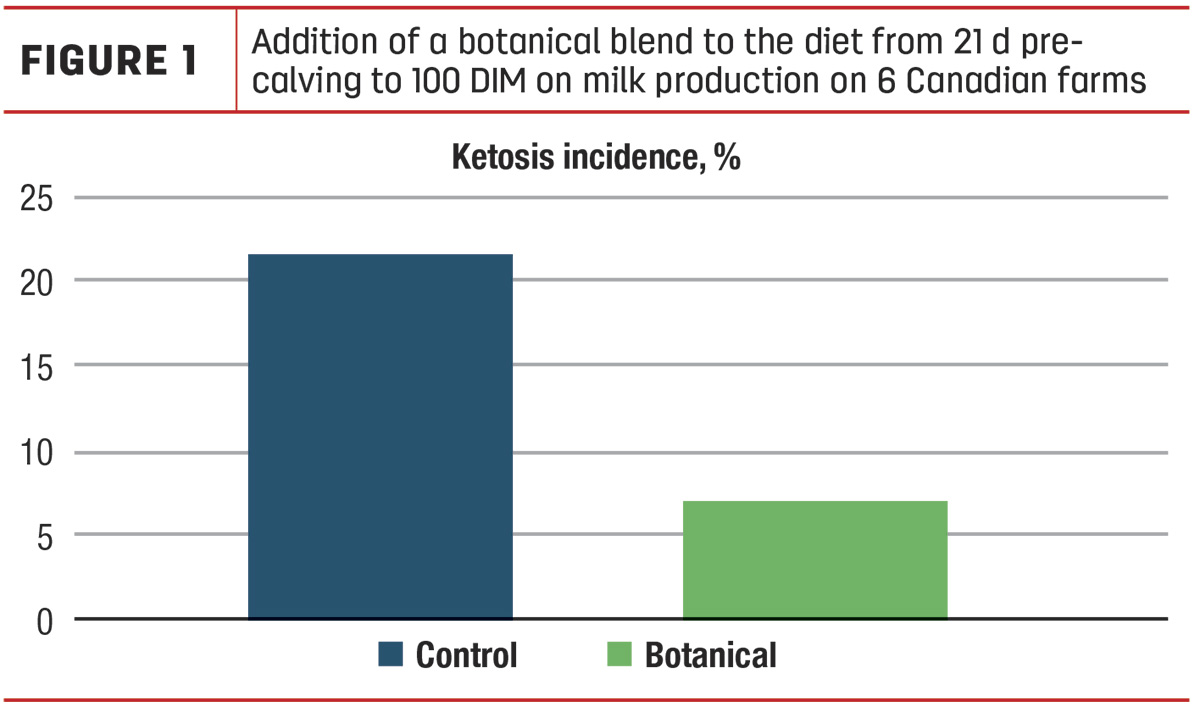The high-producing cow has a huge demand for energy to maintain her health and well-being along with the energy needed to produce the volumes of milk she is genetically driven to make. The largest component of energy needed within her body is glucose. Glucose is the only, or preferred, substrate for the nervous tissue (brain), immune system and mammary alveoli secretory cells to produce milk lactose and milk protein.
During periods of change, transition and stress, dairy cattle consume less feed than is needed for optimal well-being and performance. Yeast products that improve dry matter intake (DMI) and rumen digestion have their largest benefit and response during these periods that challenge the cow. We have developed a blend consisting of a bioactive yeast and an encapsulated botanical that has post-ruminal effects improving intake, blood glucose and milk production.
Recently, researchers in Europe introduced an encapsulated botanical to our dairy specialists that showed promise to improve energy metabolism. They found that a unique encapsulated botanical showed improved blood glucose levels and increased milk production on European farms. Interested in learning more about this product and how it could benefit farms in the U.S., we implemented the botanical from their work with underperforming dairy farms in Kentucky. These dairy farms presented a great opportunity to conduct a case study to evaluate whether this encapsulated botanical could improve the performance of lactating dairy cattle in the U.S. and provide added performance and financial benefit.
With on-farm testing, the responses observed are often more variable than in controlled trials due to control and treatment diets not being fed simultaneously. For example, if the weather suddenly improved and was more favorable when a change in diet was introduced, the response observed with the cows could be confounded with the weather. Environmental influences such as changing weather or a change in forage dry matter percentage or nutrient content can impact milk production. However, in this Kentucky case study, the size for most of the herds was sufficient to decrease individual cow effects, and when introduced over a period of several weeks, the environmental effects were expected to even out.
Case study results from the seven herds in Kentucky are shown in Table 1. Milk production in these herds increased from 2 to 6 pounds of milk. Milkfat and protein percentages were not changed. The typical milk response occurred within two to four days after the addition of the encapsulated botanical blend, and there was a clear “jump” in milk volume in the milk tank.

With the European research showing an improvement in energy metabolism, we were interested in evaluating the response when fed to transition cows. Due to the large energy deficit that fresh cows experience, a product that improves energy metabolism would be expected to have the largest response when fed from the close-up period through peak milk production.
Our nutritionists in Canada were working with dairy farms that wanted to improve startup milk production. To evaluate the potential to improve startup milk production, they conducted a case study with the same yeast and encapsulated botanical blend used in the Kentucky work. In this case study, the blend was fed for 21 days prior to expected calving and through 100 days in milk. In this study, milk production was increased from 2.5 to 13 pounds (Table 2). Most interestingly, the incidence rate of ketosis was decreased from 22% to 7% (Figure 1). Though on-farm testing response rate is much more variable than in controlled trials, a positive milk yield response was observed on all six farms and resulted in a 7.5-pound average milk response across all the farms.


Using these two case studies, we have found that an encapsulated botanical increases milk production by an average of 4.5 pounds of milk, and when fed to close-up cows, increases milk production by an average of 7.5 pounds of milk. The results observed in these two case studies are similar to a controlled research trial conducted by our researchers in Indiana whereby the encapsulated botanical was fed in the transition period for 21 days prior to the expected calving date through the first 60 days of lactation, increasing milk production by 5.7 pounds of milk.
As we learn more about natural means to stimulate both milk and milk component production, as well as enhance the health and well-being of the animal, specific botanical blends have been shown to be very effective. We are excited about the opportunities these compounds can provide dairy producers. Research continues into this emerging area to further understand mode of action and develop and merge technologies to provide consistent and cost-effective benefits for dairy producers. As on-farm use grows and further evaluation is conducted, we will gain additional insight needed to apply botanicals as yet another tool to optimize both performance and profitability in all phases of dairy production.
Trial info available upon request.
Brian is a dairy farm nutritionist and management consultant and dairy cattle nutrition researcher at ADM.






